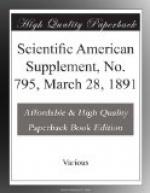In the year 1872 he had two patents granted him for improvement in water wheels, but never had any wheels built of that pattern. After completing and patents granted for his new improved Standard turbine, he was perfectly satisfied, and often remarked, “I cannot improve on my register gate turbine any more, as it is as near perfection as can be made,” and he was fully convinced, for the past year he was experimenting with a cylinder gate turbine, and patent was granted Oct. 21, 1890. Previously he had made a 24-inch wheel, which was tested Aug. 14, 1890, at Holyoke testing flume, and gave fair results, and at the time of his demise he was having made a new runner for the cylinder gate turbine, which we will complete and have tested. His idea was to have us manufacture and sell register and cylinder gate turbines. His inventive powers were not confined to water wheels, for on Feb. 23, 1886, patents were granted him for automatic steam engine, governor and lubricating device. We also remember in the year 1873 or 1874, when his mind was occupied with his “Standard turbine,” he was hindered by some device used now on locomotives of the present construction (what it was we are unable to say), but when draughting at his water wheel, would conflict the two, and by his invitation we wrote to a prominent locomotive builder and had him examine the drawings, which he had not fully completed, and sold same to him. Of this we only have a faint recollection, but do recollect his saying: “Well, that is off my mind now, and I can devote it to the finishing of my new wheel.”—American Miller.
* * * * *
ALTERNATE CURRENT CONDENSERS.
At a recent meeting of the Physical Society, London, Mr. James Swinburne read a paper on alternate current condensers. It is, he said, generally assumed that there is no difficulty in making commercial condensers for high pressure alternating currents. The first difficulty is insulation, for the dielectric must be very thin, else the volume of the condenser is too great. Some dielectrics 0.2 mm. thick can be made to stand up to 8,000 volts when in small pieces, but in complete condensers a much greater margin must be allowed. Another difficulty arises from absorption, and whenever this occurs, the apparent capacity is greater than the calculated. Supposing the fibers of paper in a paper condenser to be conductors embedded in insulating hydrocarbon, then every time the condenser is charged the fibers have their ends at different potentials, so a current passes to equalize them and energy is lost. This current increases the capacity. One condenser made of paper boiled in ozokerite took an abnormally large current and heated rapidly. At a high temperature it gave off water, and the power wasted and current taken gradually decreased.




